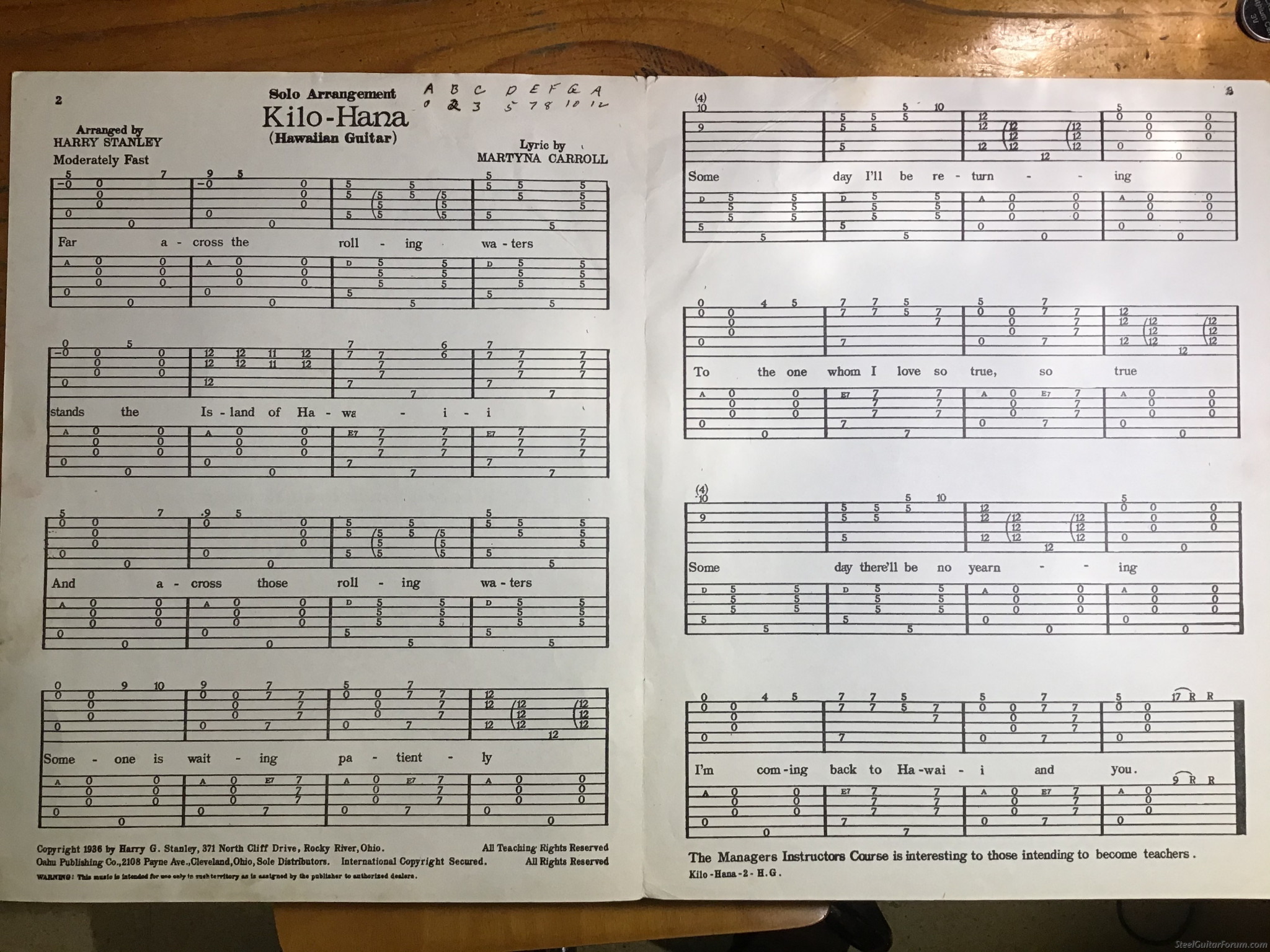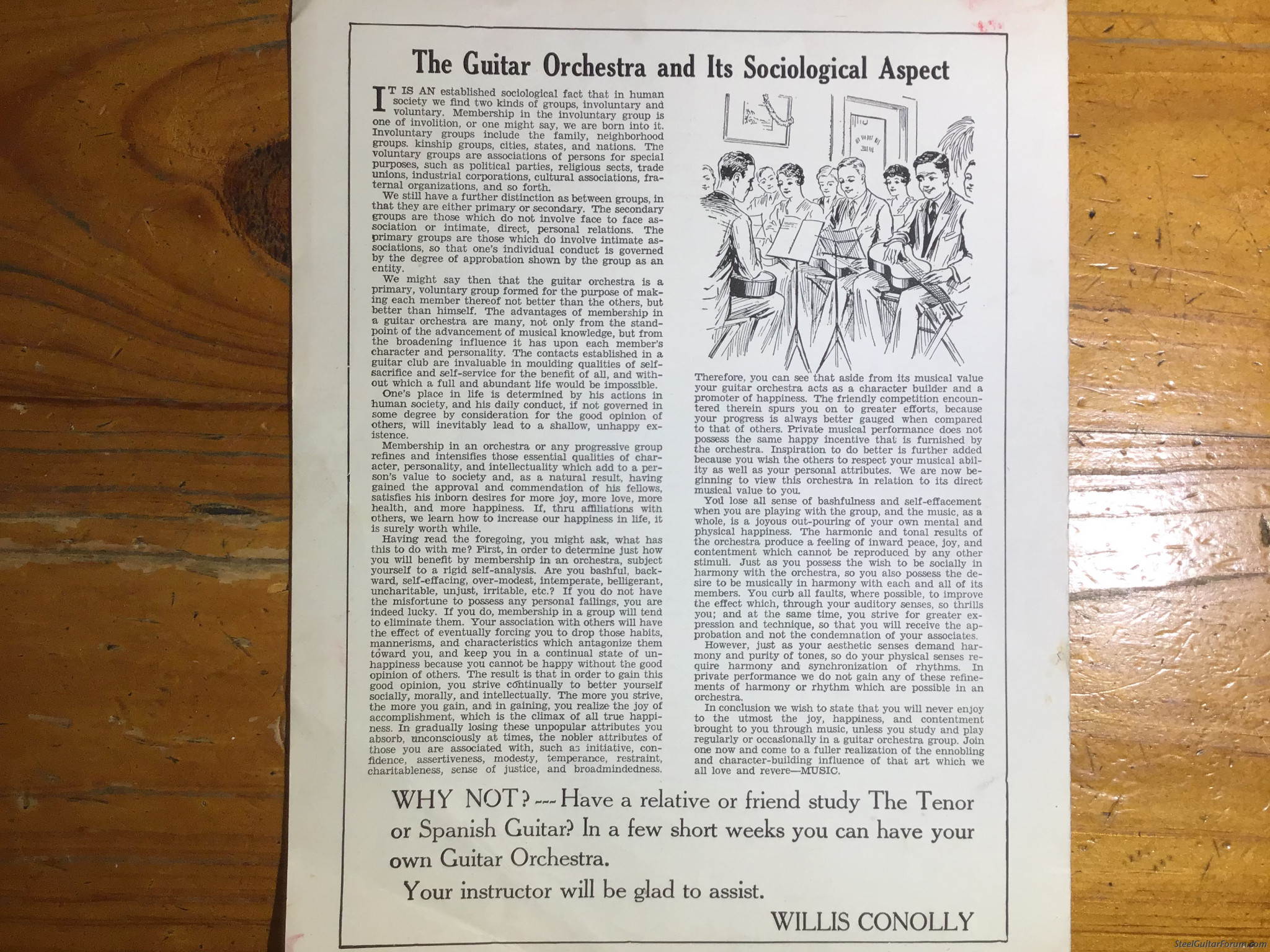| Author |
Topic: Oahu Orchestration for Hawaiian Guitar |
Jeffrey Ross
From:
Victoria, Australia
|
 Posted 20 May 2020 5:53 am
Posted 20 May 2020 5:53 am |
|
Against gentle advice not to, I bought 50 Oahu Orchestration tablature, Hawaiian Guitar, sheet music charts. Apart from the sublime music, they are things of beauty & contain wonderful advertisements & cultural notes from the 1930s-40s. None of them show a guitar tuning; the structure is 6 lines with the string & fret indicated above the line.
Is there a guide, anywhere, to reading Oahu Orchestration tab? |
|
|
 |
Ron Funk
From:
Ballwin, Missouri
|
 Posted 24 May 2020 6:48 pm
Posted 24 May 2020 6:48 pm |
|
Jeffrey -
I agree with you, the old Oahu music sheets are truly works of art.
Oahu published its music in a variety of different tunings with C6th probably being the most frequent.
If you could post a pic (or two) of tab for a song that we might know, that should help Forum Members determine the tuning for that specific song.
Ron |
|
|
 |
Jeffrey Ross
From:
Victoria, Australia
|
 Posted 26 May 2020 5:45 am Oahu Orchestration for Hawaiian Guitar.
Posted 26 May 2020 5:45 am Oahu Orchestration for Hawaiian Guitar. |
|
G’day Ron,
I took a chart to my local music shop & my Guyatone HG 76A. The guy started to play the cord part of the duet & came up with, Low to High, EAEAC#E.
I subsequently found other posts here and George Rout’s posts were particularly helpful. George described 2 A Major tunings used by Oahu in the 1930s, A Major Low Bass as above and A Major High Bass AC#EAC#E.
Thanks for your reply.
 |
|
|
 |
Jeffrey Ross
From:
Victoria, Australia
|
 Posted 26 May 2020 6:28 am Oahu Orchestration for Hawaiian Guitar.
Posted 26 May 2020 6:28 am Oahu Orchestration for Hawaiian Guitar. |
|
What I am rather hoping for is a lesson, leaflet, or booklet explaining how Oahu indicated slides, hammer ons, pull offs, slants etc.
The Kilo Hana chart is pretty bare in that respect, but the If You Were Only Mine chart is full of mystery to me, given that I have only the Hal Leonard Lap Steel Guitar book to go by at the moment.



 |
|
|
 |
Jim McGinnis
From:
Owasso, OK USA
|
 Posted 4 Jun 2020 10:23 am
Posted 4 Jun 2020 10:23 am |
|
Oahu, would normally write the tuning on the top of the song. That song appears to be the A tuning (E,C#,A,E,A.E)high to low.
Sometimes they would include two tunings on a song. Usually A and E (E,B,G#,E,B,E) or Am7 (C6th) and C#m etc.
I took 24 Oahu lessons from a couple brothers in Coffeyville, Kansas some 65 years ago. I don't remember any written explanation for what you are asking but I'll look at my old music and see if its available.
They had some really nice arrangements. Sometimes they would include harmony parts.
_________________
Jim McGinnis |
|
|
 |
Jeffrey Ross
From:
Victoria, Australia
|
 Posted 27 Jun 2020 6:11 pm oahu Orchestration for Hawaiian Guitar
Posted 27 Jun 2020 6:11 pm oahu Orchestration for Hawaiian Guitar |
|
Many thanks Ron & Jim. Erv Niehaus was able to tell me Ph stands for Palm Harmonics & the curved lines represent 1/8th notes.
The capital H, circled in blue above is explained as Harmonic, printed on Chimes Waltz, Chart (710).

I am indebted to the student who defaced his/her One Two Three Four, Chart (721) pointing out the Tenor, Melody & Chord parts of the chart. Also for pointing out the hyphen -0, -5 etc meant that this string is picked FIRST. That explains the hand written note -0 pick, but not 5 Hula. It would be good to know what the (3) above 9 & R curve 12 mean in the Tenor part at the top of the chart.

In measure 4 of My Fireside Sweetheart, Chart (758) there is a forward facing arrow head >, this is an ACCENT according to When You And I Were Young, Maggie, Chart (742).
Also in measure 4 there is an upward curved line before the four fret 15 notes and then straight lines down to the four fret 14 notes, repeating up and down six times to the capital R.
What does R mean?
Are those strings picked or strummed?
Do the straight lines represent a slant held between 14 & 15 for seven 1/8th notes?

In, I Want Somebody To Love, Chart (757), do the squiggly lines circled indicate VIBRATO?
Does tr squiggle stand for TREMOLO? tr without squiggle appears in measure 12 above (4) & 8, any ideas?
Thanks again, I am slowly building a glossary and help with any of the above will be greatly appreciated. |
|
|
 |
George Rout
From:
St. Catharines, Ontario, Canada
|
 Posted 29 Jul 2020 6:43 am
Posted 29 Jul 2020 6:43 am |
|
Hello. I was just glancing at the Fourm here this morning and saw my name!!!!! This Oahu TAB is mysterious unless you have taken lessons. I say that, because the teacher told you what this and that meant. You got a page of TAB (number system they called it then), seldom with any explanations. I have a lot of old books going back to the 20's and 30's some of which had their own markings meaning something or another.
An "R" means a rest of one beat. An "R" with a number "2" above it in parenthases brackets for example, means you hold that rest for 2 beats. One beat is the picking of the note, the second beat is holding the note for one more beat.
Now the curved lines joining the numbers turns those notes into 1/8th notes. However, because you can't readily come to the first note and instantly turn it into an 8th note, the two notes quickly picked are the following 2nd and 3rd notes. You still have to keep the timing 3/4 or 4/4.
If you take a tune that you know well and play it while reading the TAB, you will be able to corelate the sound timing to the characters.
Seldom is anything showing for "hula picking" frequently used in the old picking style. For example, if you have a 5 on the top string, and a 0 right below it on the 2nd string and another 0 in the same vertical line on the fifth string, with your index finger you pick the 2nd string first, followed by the first and fifth strings together, not as two distict notes, but more like a quick "D/Dah".
There are many symbols. Another infrequent one is 5 on the first string and a 0 on each of each of 4 of the 5 strings inline below. Immediately before that figure, there will be a small zigzag line from in front of the top to the 5th string, indicating that you put your thumb pick on the bottom string and slide it up picking each of the five strings including the top one.
That symbol was frequently used at the end of the song followed by two or three rests depending upon the timing.
It's been fun teaching this old style.
Geo
_________________
http://georgerout.com
"I play in the A Major tuning. It's fun to learn and so easy to play. It's as old as the hills....like me" |
|
|
 |
Stephen Goode
From:
Danville, Illinois USA
|
 Posted 22 Dec 2020 3:30 pm
Posted 22 Dec 2020 3:30 pm |
|
| I'm 80 yrs. old and I learned to play the OAHU method back in the late 40s to early 50s. The top staff was the melodic line and the bottom staff was the harmonic line.The teacher would teach you to play the melody line while he would play the harmony line. Most of the tunings that we used was - E major, E7th, A and A minor. My favorite was the A minor. |
|
|
 |




